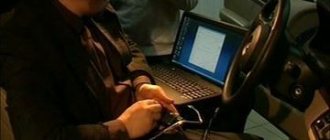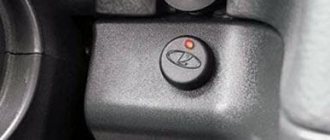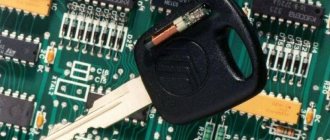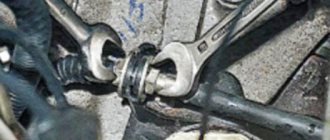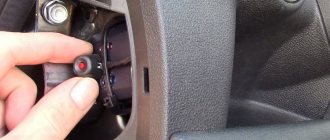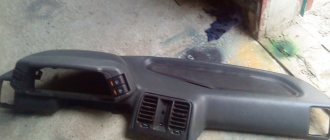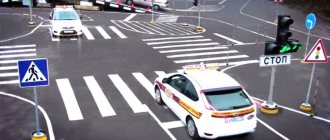01/26/2022 7,740 VAZ 2115
Author: Ivan Baranov
All modern cars, including vehicles of the domestic automobile industry, are equipped with immobilizers. Immo is an anti-theft device that allows you to block the engine in the event of a car break-in. But like any other electronic device, over time this device may break down or begin to “glitch”; in such cases, car owners are faced with the need to turn it off. How to disable the immobilizer on a VAZ 2115 with your own hands - we will talk about this below.
[Hide]
How to quickly, easily, and most importantly correctly disable the immobilizer on a VAZ 2115?
All modern cars, including vehicles of the domestic automobile industry, are equipped with immobilizers. Immo is an anti-theft device that allows you to block the engine in the event of a car break-in. But like any other electronic device, over time this device may break down or begin to “glitch”; in such cases, car owners are faced with the need to turn it off. How to disable the immobilizer on a VAZ 2115 with your own hands - we will talk about this below.
What is an immobilizer in a car?
Needless to say, no other protection was required then. Vehicle thefts were extremely rare. Today the situation has changed dramatically.
When the number of thefts increased, the question was raised about creating a unique driver recognition system that could create effective protection with a car alarm.
And suddenly they were able to find the necessary solution. Almost every vehicle has an installed immobilizer - a modern security system.
This name is familiar to all of us, however, only a few car drivers are aware of the important points and method of operation of such equipment. Now let's find out what immobilizer 2115 is in a vehicle and how it can work.
General information
To begin with, it will be useful to find out where the immo is located, because if this device does not work, to disable it you need to gain physical access to the device. In VAZ 2115 cars, the immo is located behind the center console, to the right of the steering wheel.
Today there are two types of devices - contact and non-contact. Contact systems are controlled using keys, while contactless systems are controlled using special chips built into a key fob or card. In the case of VAZ cars, immos are installed only on injection versions of cars.
Principle of operation
The operating principle of this device is based on data exchange between the control unit and the immo. The anti-theft device transmits data to allow or prohibit the start of the power unit. If prohibited, the system automatically blocks the ignition circuit with the fuel pump, and accordingly, starting the engine will be impossible. That is, without initialization the power unit will not be able to start.
In what cases should it be disabled?
In what cases do you have to disable the anti-theft installation:
- If you are dealing with a manufacturing defect, that is, a defect. In particular, we are talking about the first versions of cars on which such devices were installed. In later variations, VAZ engineers added the function of alternative engine start, bypassing the protection. But you need to take into account that in this case the option will work only once - if a failure occurs, you must enter the access code, then activate the function and press the gas pedal a certain number of times. Moreover, this operation will need to be repeated 6 times. For example, if your password is 123897, then first you press the pedal once, then twice (after a short period of time), then three more times, then eight times, etc. This function is described in more detail in the service manual.
- If the battery is completely discharged, the control unit may record this as an error, which will not allow the engine to start in the future. As mentioned above, the control module and the immobilizer interact with each other through a diagnostic line. So if the circuit loses power, it is perceived as an error.
- Also, blocking can be carried out due to the control unit. For example, if a driver uses diagnostic equipment to test vehicle systems, a code failure may occur. The ignition must be turned on. Moreover, the cause of the failure may also be due to interference emitted by the smartphone.
- Also, the need to bypass immo may arise as a result of banal failures in its operation (the author of the video is the IZO channel)))LENTA).
What is engine blocking with a car alarm?
The vast majority of anti-theft alarms, among their numerous security functions, also contain the ability to block the engine.
As a rule, a standard immobilizer is responsible for this, the task of which is to identify the real owner of the vehicle and, if successful, unlock the power unit. But the same function is also equipped with purchased alarms installed in a car in addition to standard equipment or in their absence. According to statistics, over 50% of cases of engine failure are associated with one or another malfunction of the car alarm. It is worth noting that the complexity of unlocking the engine in such cases is an order of magnitude simpler than in the presence of complex integrated anti-theft systems. So if you have a regular alarm installed, the chances of unlocking the power unit on your own are quite high. Of course, if you have a good understanding of how a specific implementation of the system works and what should be done to fix the problem.
In any case, anti-theft systems, standard or installed after purchase, operate under firmware control and are part of the vehicle’s electrical equipment. The reasons for their malfunction are rarely due to mechanical failures: much more often, electronics fail, and such failures can be isolated or frequent, almost constant. It is advisable not to let things get to the last point, because the sooner a problem is discovered, the easier it will be to diagnose and fix it. You also need to understand that the severity of the malfunction will not correlate in any way with the specific make/model of the vehicle - everything will depend on how complex the implementation of the anti-theft system is.
Can accidental activation of the alarm functions prevent the engine from starting? Of course, therefore, first of all, you should check the condition of the key fob for the presence of atypical pictograms or inscriptions
If there is a warning light (LED indicator light), you should pay attention to its behavior. Thus, rapid blinking will indicate that the immobilizer anti-theft mode is activated
Let's look at methods for diagnosing StarLine car alarms. If, when you turn on the ignition, the starter does not start, the warning light begins to flash rapidly and at the same time the immo message appears on the key fob:
- you need to try to pull the key out of the central locking and then press the central locking key on the key fob;
- the second option is to get out of the car, sequentially turn on and off the security function and then try to start the engine.
Both actions are aimed at ensuring that the security system is operating as normal. Every third case of blocking occurs due to unintentional interference with software settings. If you suspect this, you should sequentially disable all additional modes.
StarLine is characterized by the presence of a two-component unlocking function, and the activation of this mode often occurs accidentally. In such cases, you can unlock the car alarm by holding down button 3 for several seconds until two sound signals are issued in the form of two short squeaks. Then you need to press three (short) and one (long) again. As you can see, the algorithm is quite complex, and on other anti-theft systems it can be implemented completely differently.
Instructions for disabling immo
If your car is equipped with an alarm or central locking, then you don’t have to worry about the safety of the car when the immo is turned off. If you do not know how to turn off the alarm, then this procedure is carried out using the service button, which is usually called Valet. The shutdown procedure is described in more detail in the service manual. We will not describe it, since it is individual for each individual car model.
As for immobilizers, they are disabled according to the following principle:
- First you need to disconnect the control unit connector.
- Next, you need to dismantle the control unit; to do this, unscrew the side covers in the so-called doors on the console using a screwdriver, then disconnect the terminals and remove the device.
- Now you need to read the EPROM. EPROM is a non-volatile memory; it is needed because it contains data on the operation of the anti-theft device. After completing the work, the EPROM is installed in place.
- After this, you need to disconnect the PAK loader from the control module.
- Disconnect the module so that the device is not automatically blocked during installation.
- Next, we proceed to dismantling the immobilizer itself. As mentioned above, it is located behind the center console, in the area of the steering wheel. The block is located at the audio system level.
- You need to feel and disconnect the plug with your hand; there are 20 contacts on it. Having done this, you can begin to restore the K-Line, for this you will need to close the contacts on the connector, in particular, we are talking about outputs 9 and 18. That is, they must first be cut and then insulated. Having done this, reinstall the block and try to start the engine. If you did everything correctly, the engine will start.
Tips and tricks
If attempts to remove engine locks and start the engine are unsuccessful, then there is a high probability of a serious malfunction or failure of individual alarm elements. The result is random activation of engine locks, which cannot be disabled using standard methods. The faulty car must be taken to a service station, as removing the lock will require professional intervention.
The specified delivery can be carried out by tow truck. Another affordable way is to call an auto electrician who works on-site. Note that the final costs of paying for the service of on-site engine unlocking, disabling the car alarm, emergency opening of locks, etc. often turn out to be less than delivering the car to a service center by tow truck and paying for repairs at a technical center.
Source
as91 › Blog › VAZ immobilizer
Hi all. In the text I will mention the abbreviation ECU - electronic control unit. They are often called "brains". I won’t tell you what an immobilizer is, it’s written about in the previous post, let’s get straight to the point. Today I will talk about immobilizers APS-4 and APS-6. The abbreviation APS stands for: Automotive Anti-Theft System. Let's start with APS-4. APS-4 was installed on early VAZs sometime before 2007. Tens, chisels, etc. Works with MP7.0, M1.5.4 (Bosch) and January-5 ECUs. NOT installed on priors, viburnums, shnivy. They had APS-6, read about it below. I didn’t install it on classics at all. One of the design features is that the immo key is not located in the ignition key, but on a separate key fob, which must be brought to a special place on the panel to be read. By the way, there are quite a few articles on the Internet where people remade this key fob and built it into the key, rewinding the antenna to the ignition switch. This is what the APS-4 and keychains for it look like:
Immo began to be installed on VAZs from the moment the production of injection cars began, but there was a small lapse: when they started making injectors, it turned out that there weren’t enough immobilizers for everyone. I don't know why this happened. Either the plant couldn’t cope, or they were saving money, but among the first cars there were cars both equipped with an immobilizer and without it, although all the wiring for it was there - only the unit itself was missing. Because of this, a dilemma arose - what to do? The solution was ingenious - they decided to supply cars with an immoblizer, but not included in the car's ECU. That is, the box simply dangled in the wiring until the new owner decided to activate it. Accordingly, if there was no immo, there were no problems. Here is an example of how to activate the immobilizer, taken from the instructions for the APS-4 unit:
• Turn on the ignition, the APS LED lights up • Bring the red key • Turn off the ignition without removing the red key. • Short squeak. The APS LED should start flashing. • Bring 1 black key. • Squeak. The LED goes out temporarily. • Bring 2 black keys. • Squeak. The LED goes out temporarily. • Bring the red key. • Squeak. The LED lights up. • Turn on the ignition. • Squeak. The LED goes out. (On MP7.0 the LED continues to light. You must turn off the ignition no later than after 10 seconds.) • Turn off the ignition.
After activating the immobilizer, a code was written into the memory of the car's ECU and then worked with it. I note that the ECU, having not received the go-ahead to start from the immo, turned off not the injectors, but the fuel pump and ignition control. The next blunder was that if on a car with activated immo you put the brains from a car with not activated immo, then the car will start... If anyone wants to know whether their immo is activated, then here is an excerpt from the manual (applies only to APS-4) : The immobilizer training procedure is assigned to dealers, but unfortunately not all of them carry out this procedure. Therefore, for further actions it is necessary to be able to determine whether the immobilizer is clean or trained. This can be determined by the time the LED turns on in the standby state. The immobilizer is in the standby state (ignition is turned off, the driver's door is closed) after the interior lighting goes out. In this state, the LED flashes once every 2.5 seconds, but if the immobilizer is clean, then the time the LED is on is 0.5 seconds, and if it is trained - 0.1 seconds.
Location of the immobilizer on the VAZ-2114
Location of the APS-4 immobilizer on the car
Since the beginning of the 2000s, an automobile anti-theft system (APS) has been installed on all injection engines produced in Tolyatti.
The standard anti-theft system is otherwise called an immobilizer.
The meaning of the system is as follows: an attempt to steal a car will end in nothing. The attacker will not be able to start the engine, and if he does start it, then after driving a few hundred meters the fuel supply will stop and the engine will stall.
The idea is good, but there are a number of problems that arise during its operation:
- Software failure. The electronics does not see the update of information supplied by the ignition key or does not recognize it. There were cases when, having stopped and turned off the engine, it was no longer possible to start it.
- Engine blocking due to low battery. Leaving your car in a parking lot for several days in winter can accidentally activate the system.
- Serious problems when connecting an alarm system with auto start.
- Breakdown, contact closure due to poor location.
Interesting! The first injection VAZ-2114 were produced either without APS, or with an unconnected unit dangling inside on its own wiring. Nobody knows what this was due to (savings, lack of equipment or another reason), but the fact remains.
In the case when a car with an active immobilizer does not communicate with the computer, you need to know the following: the K-Line wire connects the diagnostic connector and the APS. Only then does the power enter the electronic control unit.
In the event of a malfunction, you need to make sure that the system is connected to the correct connector. If the result is positive, you can try to disconnect it and bridge the 9th and 18th contacts.
This will result in a direct connection between the ECU and the diagnostic connector, bypassing the anti-theft system.
In case of malfunctions related to the operation of the immobilizer, it is necessary to take into account the fact that this is a complex electronic device. Therefore, to troubleshoot it, it is recommended to contact a professional auto electrician.
Important! In the event of breakdowns associated with its operation, you need to know that restoring functioning after the intervention of unskilled hands can be difficult, and in some cases completely impossible.
The Bosch ECU on the VAZ-2114 came complete with an APS-4 immoblizer
When deciding whether to deactivate the immobilizer or not, you need to know the following. APS-6 or 4, although it has a number of significant drawbacks, it really counteracts hooligans who may decide to ride in a car parked near the entrance. The alarm does not turn off the engine and fuel system.
The anti-theft system of the 6th series, on the contrary, turns off the power to the fuel injectors (the 4th turns off the fuel pump and glow plugs). Therefore, it’s up to you to decide whether to connect it after the next glitch or not. But at least, if they decide to steal a car, then they will need their own ECU; you can’t take the car with your bare hands.
The device of the standard immobilizer APS-4
First, let's figure out what this immobilizer model is and what functions it performs. This kind of device is designed to prevent the engine of your car from starting in cases where access to it is recognized by the system as unauthorized, that is, in the event of a possible theft.
The standard APS-4 set includes a set of keys with an electronic code written on them (a pair of black ones are the main “working” ones, a red one is “programming”), an indicator sensor (a light bulb near the ignition switch) and a control unit that functions in conjunction with the electronic system car control. The code information recorded on the keys when “learning” the system is individual for each APS, and, as a rule, is installed when purchasing a car (you can learn more about “learning” working keys from the instructions included with the device).
Remember that the keys must be stored carefully - losing the red “training” key will deprive you of the opportunity to re-write working keys.
This can lead to a complete replacement of control and monitoring units in the event of malfunctions. When the ignition is turned off, the immobilizer is activated automatically (the buzzer will emit a short beep and the indicator will go into flashing mode every 2.5 seconds), entering the theft protection mode.
In order to activate the system, the information sensor must read information from the coded keys (you need to bring them to the ignition switch so that the system can recognize the “native” key). Only after this will the blocking of the electrical circuit be turned off and access to starting the engine will be provided. Otherwise, the car simply will not start.
Joke from AvtoVAZ
Important! When disassembling the immobilizer yourself, pay attention to the markings of its boards. The fact is that the case from APS-4 may contain a board from the 6th series. This is another, another cruel joke from AvtoVAZ
This is another, another cruel joke from AvtoVAZ.
VEHICLE ANTI-THEFT SYSTEM (APS)
The car is equipped with an APS-4 car anti-theft system (immobilizer), consisting of a control unit, a system status indicator and code keys.
The immobilizer is an electronic unit that prevents unauthorized engine starting, opening the necessary electrical circuits and works in conjunction with the electronic engine control system.
The immobilizer goes into security mode automatically when the ignition is turned off.
Checking the activity of the anti-theft system
First of all, make sure that the anti-theft system is connected and inactive. To do this, close all the car doors except the driver's door, get into the car and close the driver's door. The interior lamp should continue to light after closing the driver's door for another 12 seconds, and then go out smoothly. Turn on the ignition, the system status indicator LED should light up and stay lit while the ignition is on. In this case, you can proceed to the procedure for transferring the anti-theft system to the active state, i.e. carry out the so-called “training” of the system with code keys, which then become individual for each anti-theft system.
If, when the ignition is turned on, the system status indicator LED blinks at a frequency of 2 times per second, this means that the anti-theft system of your car has already been switched to an active state.
Disarming the immobilizer
To disarm the anti-theft system and start the engine, do the following.
1. Open and close the driver's door or turn on the ignition. In this case, the system goes into the “reading” mode of the key code, and the system status indicator LED on the instrument panel begins to blink at a frequency of 2 times per second. If the transition to the “reading” mode is carried out by turning on the ignition, the buzzer will emit a short sound signal.
2. In the “reading” mode, which lasts 1.5 minutes if the door was manipulated, or 10 seconds if the ignition was turned on, you should bring “your” working key to the indicator. After the system reads and recognizes the key code, the LED goes out and the buzzer emits a double beep. When the LED turns off, the engine can be started.
3. Turn on the ignition, the LED will light up briefly and go out, the engine should start.
The anti-theft system switches to security mode automatically after turning off the ignition and depends on the situation and the actions of the driver. If the driver’s door did not open or was open and not closed, then arming occurs after 5 minutes; If the driver's door was opened and closed, then arming occurs 30 seconds from the moment the door is closed.
In all cases, 15 seconds before arming the system, the buzzer starts beeping at an accelerating pace. If arming is not desired, then you must turn the key to the “ignition” position.
If, when you turn on the ignition, the system status indicator LED does not light up, but flashes at a frequency of 1 time per second for 20 seconds, this means the following:
1) there is no electrical connection between the engine control controller and the immobilizer unit. Check the connection in the engine control system harness;
2) the engine control controller was previously “trained” with code keys from another immobilizer unit. The engine will not start. Contact a service station;
3) if, when the ignition is turned on, the LED does not light up and blinks at a frequency of 5 times per second for 20 s, this means an error in the immobilizer unit. If this flashing does not stop even when the ignition is turned on again, you must contact a service station.
Immobilizer “learning” procedure
If you are convinced that the anti-theft system is in an inactive state, you can proceed to the procedure for “learning” (coding) code keys. To do this, follow these steps:
1. Turn on the ignition. The LED of the system status indicator should light up with a steady, non-flashing light no later than 5 s.
Possible performance problems
Unfortunately, sometimes immobilizers begin to malfunction, causing significant trouble not only to potential car thieves, but also to the legitimate owner of the car.
The code reading system is quite vulnerable to external digital interference, and therefore even trivial interference, caused, for example, by cellular communications or car diagnostic devices connected externally, can cause it to malfunction. At first, there were often cases of manufacturing defects when the system simply stopped working for no apparent reason. You also need to carefully monitor the maintenance of your battery in working condition (especially in case of long periods of downtime in the cold season) - a complete discharge of the battery is guaranteed to force you to seek help from the nearest workshop, followed by replacement of the electronic control unit of the anti-theft system, which will result in unnecessary additional expenses.
Methods for disabling the VAZ-2115 immobilizer
If you don’t have the skills to reprogram a security system, but don’t want to make charitable investments in favor of car services, that’s okay. The solution to the potential problem is quite simple: you can disable the standard immobilizer yourself. It is worth considering that this is recommended only in cases where your VAZ-2115 already has an alternative anti-theft system installed, otherwise you will simply give the green light to attackers.
So, in order to deactivate APS-4 without self-flashing and provide unhindered access to the engine, you need to do two things: completely dismantle the immobilizer itself and erase the security coding data from the memory of the car’s electronic control unit. This procedure must be carried out carefully: there is a risk that the system will regard this intervention as an attempt to steal a car and block further access.
Disabling the immobilizer in emergency situations
To combat car thieves, the introduction of special devices that prevent unauthorized engine starting is a reasonable step for automakers. But here there is a traditional “race between armor and projectile” - as soon as a new anti-theft system appears, the search for ways to bypass it immediately begins.
On budget cars, disabling the immobilizer is so simple that it is not a problem for car thieves at all: all you need to do is gain access to the diagnostic connector. Standard VAZ immobilizers (especially APS-4) have become famous more for the problems they cause to their owners than for the reliability of their protection. At least in topics like “The immobilizer does not turn off” on specialized forums, the most common recommendation is one - turn it off completely.
As an example, let's take the connection diagram of the APS-4 block
“Communication” between the immobilizer unit and the injection ECU when starting is allowed goes through a low-speed K-line, which does not have serious noise protection. Therefore, problems with starting were even caused by interference from a cell phone, not to mention attempts to start a car with a low battery, when the APS unit entered a completely random set of data into the memory of the injection ECU. After this, starting the engine became impossible until the device learning procedure was completely completed. Without a training key it was impossible to complete it at all, so disabling the immobilizer became a reasonable step.
The number of problems with the standard immobilizer on the VAZ 2113-2115 family, where the APS-4 was installed, reached such a magnitude that even the plant developed a user-programmable procedure for unlocking a “stuck” immobilizer, and many owners preferred to disable it completely.
Dialogue between immobilizer and injection computer
For APS units, as well as for other standard immobilizers, communication with the injection control unit is simple. At the moment of “training” of the immobilizer, when key codes are written in its memory, the code of the device block itself is simultaneously written in the memory of the injection ECU. After the training procedure, the immobilizer will “accept” only the registered keys, and the injection ECU will “wait” for permission only from “its” device.
If no code is entered into the corresponding memory cells of the injection ECU, then the “brains” will not wait for permission to start at all. Therefore, it is possible to disable the immobilizer without removing the injection computer if the control unit supports flashing via the diagnostic connector. For such cars, car thieves usually took with them spare “brains” - new ones, where the immobilizer had not yet been registered, or “wiped out”.
At the same time, bypassing the standard immobilizer in this way did not cause any problems with the rest of the electronics - in the standard wiring, the APS is embedded in the gap of a single bus between the diagnostic connector and the “brains”. Therefore, deactivating the immobilizer in this way only deprived the subsequent possibility of diagnosing the injection computer, and even then this problem was eliminated by a simple jumper in the connector of the APS unit.
Operating principle of the immobilizer
Data exchange between the vehicle's electronic control unit (ECU) and the safety device and the periodic cessation of impulses to start one or another system - this is the principle of operation of the standard immobilizer on 2114. Damage to the chip or its loss, failure of the device unit, damage to the wiring - all this over time leads to involuntary operation of the system. Finding the chip in the key in the immo signal processing area means permission to start the car. Forging a chip from a key to bypass the system is problematic.
A failure in the system means that any manipulations with the engine and the systems that ensure its operation are useless until the chip gives permission or the device is dismantled.
How to disable the immobilizer yourself?
If the standard immobilizer is blocked, then disabling APS-4 is quite simple. It is necessary to physically remove the immobilizer, delete information about it from the non-volatile memory of the injection computer, and then install a jumper in the immobilizer connector to restore the integrity of the diagnostic bus.
On cars of the “tenth” VAZ family, the APS is installed above the injection ECU, access to it is on the side of the center console near the pedal assembly. For the “ninth” and later “fifteenth” family of VAZ cars - behind the instrument panel, in the area of the steering column.
After the APS-4 is physically switched off, the regular smooth dimming of the interior lamp light will stop working. Since disabling the immobilizer is essentially just breaking its connection with the injection computer, you don’t have to remove the unit itself, but simply remove pins 9 and 18 from its connector, connecting them “past the immobilizer.”
The unit is now physically disconnected from the injection ECU, but the ECU is still waiting for a signal from it to allow start. Therefore, now you need to clear the EEPROM of the ECU, which is more convenient to do on units of the “January 7.2” type, where for this it is enough to assemble a simple device-programmer from two “crocodiles” to supply power and “ground” to the removed control unit, a Chinese “cord” VAG- COM from Aliexpress and several pads (for example, cut from old computer power supplies - the power pads are just suitable for drives for 3.5” floppy disks that have not been used for a long time). Pins 12, 13, 43, 44, 63 are supplied with “plus”, pins 51, 53 and the body of the unit itself are “ground”, the K-line from the adapter is connected to pin 71.
In many programs for working with injection ECU memory, disabling the immobilizer is as simple as possible - in the ChipLoader program, all you need to do is read the EEPROM from the controller, click the “Delete immo” button and upload the processed memory dump back into the controller.
Old “Bosch” control units are much less convenient in this regard, since they do not provide easy access to the EEPROM. They have to work directly with a non-volatile memory chip through a special programmer - not the best solution for doing it yourself.
How to remove the immobilizer on later VAZ models? Here it has already been improved, including the appearance of control of the standard central locking from radio keys. Therefore, it is no longer possible to physically remove the APS here, since the central locking will also cease to function normally (similar problems are possible when installing a used immobilizer unit on a car where another unit has already been trained). The engine control units themselves have also been modernized; reprogramming them can no longer be done in such a “knee-jerk” way, so it’s worth turning to specialists.
Something else useful for you:
In more modern injection systems, removing the device is already much more difficult - if the old VAZ units worked calmly with a blank EEPROM, then in the future this obvious loophole for hijackers was eliminated at the level of the injection ECU program code. It will look for communication with the immobilizer block, and using a dynamic code, which makes simple substitution of blocks impossible.
On such cars, disabling the immobilizer is possible only by flashing the injection ECU with upgraded firmware, in which the code responsible for “communication” with the immobilizer has been removed. To create such firmware, a lot of work is required - you need to disassemble the finished machine code, understand its logic and make the correct modification. Therefore, even on a familiar Logan, disabling the immobilizer can cost several times more than on the same VAZ 10, and not all control units are handled by specialists.
What does an immobilizer for a VAZ 2110 look like and where is it installed?
Frequent groundless failures, refusals to start, incompatibility with other security systems, unreliability of the elementary base and jambs during assembly force us to disable the standard immobilizer by any means. But first, let’s briefly look at the principle of operation of the device in order to understand how to deal with it.
Principle of operation
The principle of operation of the immobilizer.
The operating principle of any simple immobilizer is ridiculously simple - the device communicates with the engine control unit and gives a certain signal when unauthorized access is attempted. The ECU, in turn, gives or does not give permission to start the engine. It happens like this - to start the engine, it is necessary for the immobilizer to accept the key and only after successful initialization it sends an enabling signal to the ECU.
There are several options - cut the wires or reflash the device, the procedure for cutting the wires is as follows:
- First you need to find the system control unit. As we have already reported, in most cases it is installed behind the radio, in the dashboard.
- Feel for the connector with your hand and disconnect it from the unit. The connector itself has 20 pins.
- Next, you should first count contact number 9 from the plug, then contact 18. Take these wires and cut them with a knife. Next, these two wires must be connected to each other and insulated.
- After removing the device, it is necessary to restore the line through which diagnostics are carried out. To do this, you need to install a jumper that will restore communication between the control unit and the diagnostic block. When you cut the wires and then connect them to each other, this is how you restore the K-Line. After all the manipulations, the connector is put in place.
Proper cutting and connection of wires for disconnection
As for flashing the device, for this you will need to prepare a soldering iron with a computer in advance (a laptop will do), as well as a special PAK loader programmer.
Once you have everything in hand, you need to do the following:
- Remove and disassemble the control unit.
- After disassembly, you need to find the controller plug and connect the PAK loader to it. Having done this, you can consider the standard firmware that was installed during the production of the car.
- Similarly, it is necessary to read data through the EEPROM output.
- On a laptop or desktop computer, you must save the previously read firmware installed at the factory.
- You need to upload a new, clean EEPROM into the control unit via the connector.
- Then you can disable the bootloader, assemble the controller and install the device in place.
If your car has a ROM sealed into the control unit, you will need to unsolder it and then perform chip tuning. If you don’t want to do this, then there is a way out - you can use a utility, for example, Combiset, which has the option of clearing EEPROM without the need to resolder the board.
More detailed and visual instructions for disabling the immobilizer on VAZ 2110 cars are given in the video below (the author of the video is Dmitry Epishev).
Loading …
It should be noted that it is the VAZ 2110 immobilizer that attracts the attention of any person who decides to purchase this car. The device is a special device for depriving a car of mobility if necessary, so it is almost impossible to steal it
Everything is done in such a way that only the owner of the car can turn it on or off.
If necessary, you can make it impossible to move the car by simply turning it off. When the immobilizer is turned on, the car stalls after a certain period of time.
The second option is most often installed on a car, because if the car brakes in the middle of busy traffic on the road, other drivers will immediately pay attention to it. In most cases, after several unsuccessful attempts to start the car, the criminal simply flees the scene.
The thing is that the criminal has no idea about the presence of the device. For the most part, it is caught a few blocks from the scene of the theft, since it is visually very difficult to determine whether this device is in the car. Unlike an alarm, which creates a noise effect designed to scare criminals away from the car, the purpose of the device in question is to ensure that the theft is successful and there is a chance to catch the criminal.
The owner of a VAZ 2110 can, if desired, remove it from the car; to do this, it is enough to simply arm or disarm the device by recognizing the owner by radio frequency waves emitted by the key. However, keep in mind that by disconnecting your car from security, you risk becoming a victim of intruders.
How to bypass the immobilizer on VAZ cars
Publication date: March 11, 2016. Category: Automotive equipment.
Almost all new cars are equipped with immobilizers. These electronic devices make it possible to prevent the theft of a vehicle by disabling the “vital” systems of the car. As soon as the attacker gets into the car, he will try to start the engine and drive away. The immobilizer will either not allow this to be done at all, or the thief will be able to drive away several hundred meters, after which the fuel supply will stop and the engine will stall.
Such immobilizers can be contact or non-contact. The former have already ceased to be produced, while the latter are very popular among car owners. However, sometimes situations arise when a car enthusiast wonders how to disable the immobilizer on a VAZ 2112 or another brand. The fact is that in the brainchild of the domestic automobile industry, problems related to electronics and various devices often occur. Let's look at the main reasons for disabling the immobilizer.
Why do you have to disable the immobilizer?
VAZ began to equip immo only with injection-type cars. The first anti-theft devices of this series appeared on the VAZ 2110 and they were called APS-4. Today, more modern APS-6 models are more common. Now all cars of the 2110 to 2115 series are equipped with this particular device.
The most common problem with this device is the loss of the key or if the car owner, without knowing it, erased its code. Speaking specifically about VAZ standard immos, you can more often encounter a problem related to the fact that the lights in the cabin do not go out and, as a result, the alarm does not go off. In addition, malfunctions of the immobilizer software often occur, as a result of which its central unit does not read information about the key or considers it “not native”. As a result, when you stop to refuel, you risk being left in a stalled car.
To reprogram (marry, bypass, flash, upgrade, adapt) a device, you must first turn it off. In addition, immobilizers are usually disabled when installing a car alarm.
Bypassing the immobilizer when connecting an alarm system
Before you disable the immobilizer on the VAZ 2110, you should study all the methods for such a restart, and the first thing you should start with is this useful option from VAZ. Since it is in these cars that immobilizers most often fail, manufacturers have come up with a simple solution to this problem. Thanks to special software, you can perform an alternative start of the device and make one trip in emergency mode. However, to do this you will first need to enter a six-digit password. It is activated by pressing the gas pedal. This means that if the “reboot” code is “999999” then you need to press the gas the corresponding number of times, at the same interval. This procedure does not cause positive emotions, but in a hopeless situation or when installing an alarm system, this may be the only way to outwit the immobilizer.
Another method is the bypass module (immo crawler). A small electronic device is equipped with transmitting and receiving antennas located inside and outside. The device key or chip is also located inside the case. As soon as you start the car with the alarm, the internal antenna reads the code and transmits it to the ignition switch.
Important! If the car is started with the key, such a crawler will not work.
If one of the keys is lost, the remaining spare can be disassembled and the chip removed from it and secured to the ignition switch. After this, you can use any ignition key and the immo will be disabled.
This concerns generally accepted tricks that will help in solving such issues as disabling the immobilizer on a VAZ 2114. If you want to manually disable the immo, then you must adhere to the following recommendations.
Rules for disabling the immobilizer
Before disabling the immobilizer, you must disconnect the connector from the protection, that is, give the system a signal that the immobilizer is missing. After this, you can erase the data on the device and replace it with new ones. But in practice everything is not so simple.
If you turn off the device incorrectly, the system may perceive this as unauthorized access and the car will be completely blocked. In this situation, it will be difficult to do anything, all that remains is to call a tow truck. Therefore, be extremely careful. There are two schemes for disabling the immobilizer.
To do this, find the immobilizer control unit. Most often it is located behind the center console, next to the radio. After this, you need to find the connector on the block and remove it. In this connector you will find 20 contacts, first find the ninth and then the eighteenth. These two wires need to be cut, connected and insulated.
After this, all that remains is to remove the immobilizer and restore the line used for diagnostics (K-line). To do this, install a jumper that will restore communication between the ECU and the diagnostic block. We cut the wires and connect them, after which the connector is placed in its rightful place.
- Reflash it yourself.
For this you will need:
- PC or tablet;
- soldering iron;
- PAK-loader programmer.
Next, you need to disassemble the ECU, find the controller connector and connect the PAK loader to it. We read the factory firmware with the BIN extension. It is also necessary to read information through the EEPROM connector. After this, you need to save the factory firmware on the computer and upload a clean EEPROM to the ECU. After this, you can disconnect the bootloader, assemble the controller and install it in place.
A soldering iron will be required if the auto ROM unit will be sealed. Or you can use the COMBISET program with the EEPROM cleaning function, then you won’t have to unsolder anything.
If we are talking about a specific APS-6 immobilizer, then it will be useful to know the purpose of the immo outputs.
- The green wire belongs to the antenna coil in the ignition switch.
- Blue is responsible for the additional power relay (for power windows).
- Green-white comes from the headlight switch.
- Orange and white refers to the rear fog lights.
- Pink is a constant plus from the battery.
- The yellow wire connects to ground when the rear fog lights are turned on.
- Yellow-black refers to K-line, if it is CL 7, then we have a wire from the diagnostic block, and if CL 8, then from the EUR control unit.
- The white one goes to the antenna coil located in the ignition switch.
- The green-black one comes from the driver's side door VC.
- Brown – from VK dimensions.
- Black – mass.
- Orange refers to terminal 15 of the ignition switch.
Main problems and features of immobilizers
Immo can only interact with the ECU, so this anti-theft device is not used in carburetor cars. Immo exchanges information with the control module and, if necessary, prohibits the device from sending signals to certain nodes. This device makes the appropriate conclusions based on the code that is located in the master key chip. When the key falls within the range of the immo, the chip transmits an encrypted signal to the device, which processes it and gives instructions regarding starting the engine or prohibiting it.
- Since the anti-theft device interacts with the control unit via a diagnostic line, its operation may be impaired as a result of incorrect diagnosis.
- Various interference that even a mobile gadget can produce. Interference is usually caused by more powerful equipment and stations, but even a smartphone can be the cause.
- A manufacturing defect, due to which the device’s circuitry has “glitched” and can no longer function. As practice has shown, defective systems were often found in the first cars that were equipped with immobilizers and injection engines. In this case, the cause of the malfunction is solved either by repairing or replacing the device.
- Also, immo, like the alarm system, may stop working due to a dead car battery. This problem often manifests itself especially in winter, when batteries are more susceptible to discharge as a result of exposure of the electrolyte to low temperatures. In particular, this is true for old batteries that have already reached the end of their service life. In such cases, car owners are required to know how to turn off the alarm or immo.
- Another reason why the immo may stop functioning is a software error. Problems of this kind can be solved by qualified diagnosticians, because there is a possibility that you will have to reflash the control unit (the author of the video about the malfunction of the anti-theft system is the IZO channel))) LENTA).

